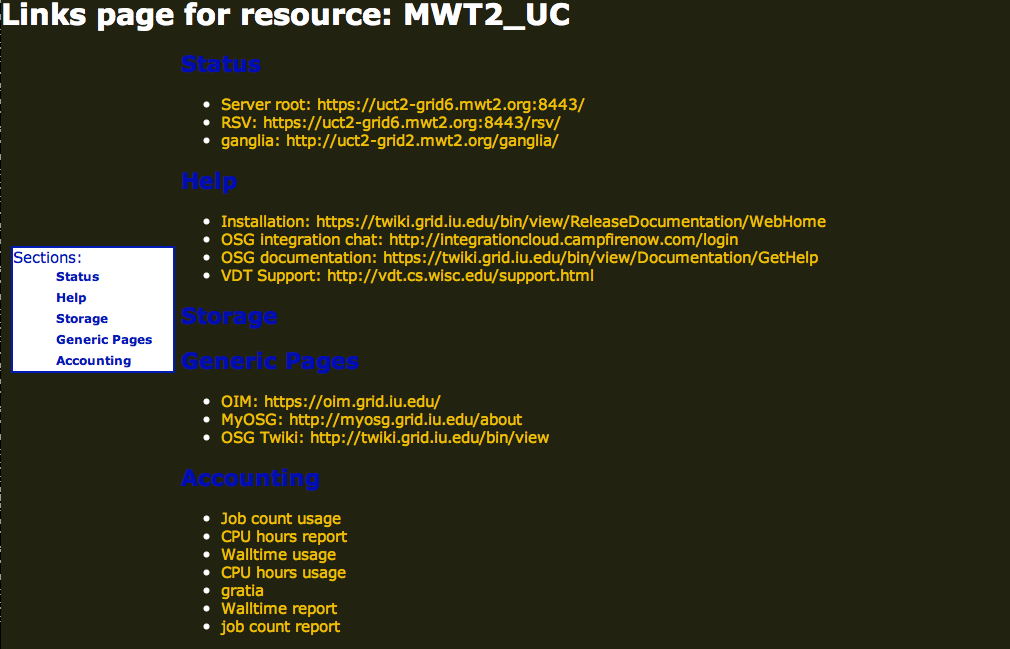You are here: Foswiki>Main Web>SiteMonitoringPortal (22 Jan 2010, MarcoMambelli)Edit Attach
Site Monitoring Portal
Description
The package is available from VDT as OSG-Site-Web-Page. It installs the binaries and some auxiliary file in the "osg" subdirectory of a VDT installation.Installation
Installation requires Pacman. You can install it in the same directory of your OSG CE (/opt/osg in the example) but it is not requiredcd /opt/osg pacman -get http://vdt.cs.wisc.edu/vdt_200_cache:OSG-Site-Web-Page.pacmanWhen in a CE installation these scripts are invoked during OSG configuration to generate the Site page if enable_webpage_creation = %(enable)s in osg/etc/config.ini. Alternatively you can run the scripts by hand (see the next section).
Use
The 2 scripts have to be used in sequence:- make-osg-portal-config - to generate a configuration (.ini) file
- make-osg-portal - to generate a html page starting from the configuration file
usage: make-osg-portal-config [-o] [-v] [-q] [-h] options: -h, --help show this help message and exit -o FILE, --output=FILE write the configuration to FILE (siteindexconfig.ini) -i FILE, --input=FILE read the initial configuration from FILE -p DIR, --path=DIR root directory of the OSG installation -v, --verbose -q, --quiet don't print status messages to stdout usage: make-osg-portal [-o] [-i] [-v] [-q] [-h] options: -h, --help show this help message and exit -o FILE, --output=FILE write HTML to FILE (siteindex.html) -i FILE, --input=FILE read the configuration from FILE (siteindexconfig.ini) -v, --verbose -q, --quiet don't print status messages to stdoutNotes about options:
- -p is not necessary if the OSG setup has been sourced or the OSG_LOCATION variable set correctly
- -i make-osg-portal-config can use as input a previously generated, and eventually modified, configuration file. This allows not to loose by hand edits of the configuration file
Quick start for manual operation
In a CE you can have the CE handle the page creation during its configuration. Supposing that your OSG installation is in /opt/osg, to create the index page you can execute:make-osg-portal-config -p/opt/osg make-osg-portal -o /opt/osg/apache/htdocs/site.htmlIf you source the setup file of your OSG installation there is no need for the "-p" option. At the end you'll have a Web page like: https://uct2-grid6.uchicago.edu:8443/site.html:
 After the first installation you should use the following so that you can keep the modification made to the configuration file.
make-osg-portal-config invocation is not necessary if there have been no changes to OSG configuration. Use the previous sequence if you want to start from a clean configuration.
After the first installation you should use the following so that you can keep the modification made to the configuration file.
make-osg-portal-config invocation is not necessary if there have been no changes to OSG configuration. Use the previous sequence if you want to start from a clean configuration.
make-osg-portal-config -p/opt/osg -i siteindexconfig.ini make-osg-portal -o /opt/osg/apache/htdocs/siteindex.html
Known problems
Guessing RSV server
The scrips assume that your gatekeeper is also the RSV server. This may not be correct. Workaround: modify by hand the configuration file or the links producedGuessing storage resources information
dCache provides some useful webpages but there is noway to guess which is the machine that is serving the information. All information systems point to the SRM server, not the http one. Workaround: modify by hand the configuration file or the links produced -- MarcoMambelli - 04 Jun 2009| I | Attachment | Action | Size | Date | Who | Comment |
|---|---|---|---|---|---|---|
| |
sitepage.png | manage | 117 K | 04 Jun 2009 - 20:27 | MarcoMambelli | site index page |
Edit | Attach | Print version | History: r3 < r2 < r1 | Backlinks | View wiki text | Edit wiki text | More topic actions
Topic revision: r3 - 22 Jan 2010, MarcoMambelli
 Copyright © by the contributing authors. All material on this collaboration platform is the property of the contributing authors.
Copyright © by the contributing authors. All material on this collaboration platform is the property of the contributing authors. Ideas, requests, problems regarding Foswiki? Send feedback


